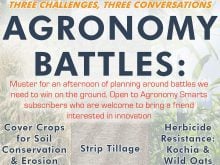Moisture was a welcome visitor on the parched Prairies this year but it brought along unwelcome problems.
Ergot infestations are up in crops around Edmonton, one of the wettest regions, said Kevin Sich, general manager with Louis Dreyfus Canada Ltd. in Joffre, Alta.
He said the area received good moisture but also dealt with ergot and sprouting.
The highly poisonous ergot is spread by flying insects and usually noticed when crops are ripe.
An area extending along Highway 2 in Alberta seems to have been hardest hit. Saskatchewan and Manitoba also had significant moisture, but early frosts account for most of their crop quality downgrades.
Read Also

VIDEO: Agritechnica Day 4: Robots and more robots, Nexat loves Canada and the trouble with tariffs
Agritechnica Day 4: Robots and more robots, Nexat loves Canada and the trouble with tariffs.
Sich said the permitted levels of ergot in higher grading grain are low.
“It’s pretty well zero.”
It can be cleaned on gravity tables and in seed cleaning plants or blended with other grain, but an ergot granule’s size is similar to a kernel of grain. Cleaning is expensive and often results in removing up to 15 percent of unaffected wheat, he added.
“Producers are reluctant to do that.”
Ergot can be controlled before it shows up at the elevator by maintaining adequate copper levels in the soil either by soil or foliage applications, said Ieuan Evans of Agri-Trend Agrology in Edmonton.
As well as avoiding planting rye crops on the same land in successive years, Evans also suggested mowing headland grasses after head emergence because ergot generally is seen at the edges of fields.
“If farmers prevent wild grass in fields from flowering, there would be no ergot,” Evans said.
Rye and many grasses are especially susceptible because they are open pollinated, he added.
Wheat, barley and oats are close pollinated so are usually less affected but copper deficiencies cause pollen sterility and force florets to open to pick up pollen.
“Ergot in wheat 95 percent of the time is an indication of low to deficient copper,” he said.
Evans said copper deficiency is seen in wet seasons because of shallower rooting, higher organic levels and lower availability of copper in the top 15 centimetres of soil.
It results in up to 75 percent yield losses and crop downgrades to No. 3 from No. 1.
He identified low copper levels at Alberta sites he surveyed this year in Westlock, St. Paul, Stony Plain, Vermilion, Beiseker and Sedgewick.














